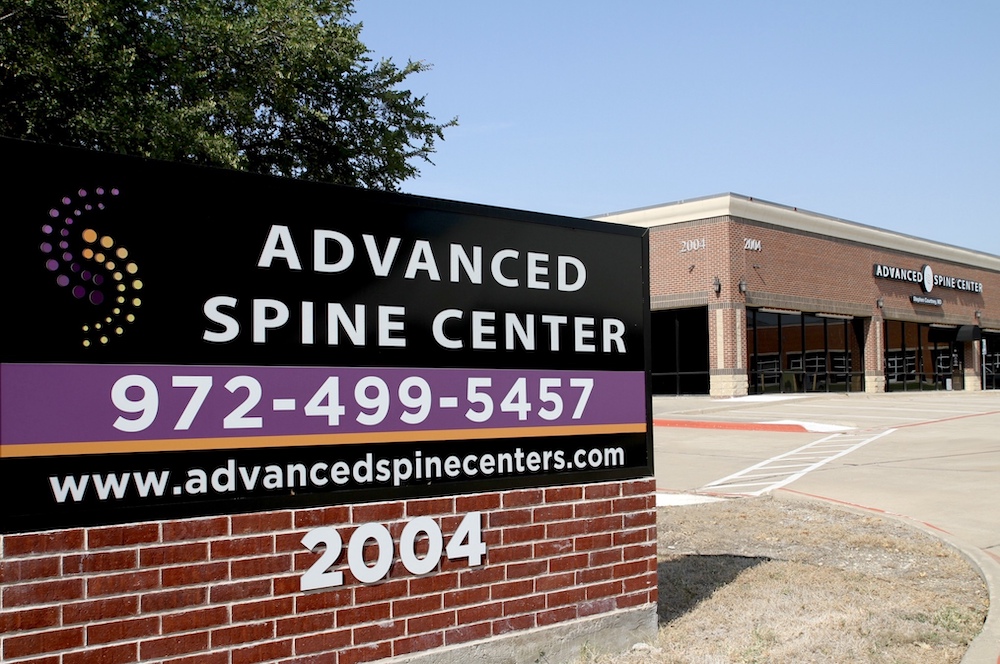Specialties
Cervical Revision Doctor in Plano
When considering cervical revision surgery in Plano, visit orthopedic spine surgeon Stephen Courtney, MD, at Advanced Spine Center. With more than 20 years of experience serving men and women in Plano, Texas, Dr. Courtney delivers top-notch, technically skilled, and conservative surgical procedures.
As a trainer and surgical equipment developer, Dr. Courtney has the knowledge and expertise you want when getting a cervical revision. To set up an appointment, book a consultation online, or call Advanced Spine Center today at 972-499-5457.
What Is Cervical Revision Surgery?

When a patient undergoes surgery on their cervical spine, there is always a small chance it could fail. This is true for any surgical procedure, as there is no guarantee that complications won’t happen. However, when a cervical spinal fusion, anterior cervical discectomy, or other cervical spine surgery fails, this can leave a patient with significant pain.
That’s where cervical spine revision surgery comes in. Revision cervical spine surgery is a procedure that aims to correct issues from an earlier spine surgery. Generally, patients with chronic neck pain after their first surgery could benefit from a revision surgery. Other issues that can signal the need for revision spinal surgery include the following.
- Wrong site surgery
- Excessive scar tissue formation
- Unsuccessful surgical outcome
- Wrong diagnosis before surgery
- Non-union after spinal fusion
- Other postoperative complications
When Is Cervical Revision Recommended?
Cervical revision surgery may be recommended for a number of reasons. Dr. Courtney performs cervical revisions when previous cervical spine surgeries have failed due to:
- Pseudoarthrosis (failure of the bone to fuse after surgery)
- Adjacent segment disease (ASD)
- Incomplete decompression
- Hardware problems, such as implant failure
Post-surgical infections can also cause progressive deformity, especially as pathogens can quickly destroy the bone. Dr. Courtney can revise initial surgeries when necessary to relieve your pain, improve your quality of life, and help you return to your favorite activities.
What Is Failed Neck Surgery Syndrome?
Failed neck surgery syndrome is a condition that occurs when a patient has persistent neck pain after undergoing one or more cervical spine surgeries. A similar condition that affects the thoracic and lumbar spines is called “failed back surgery syndrome.” Many factors, including preoperative, operative, and postoperative can lead to chronic pain after surgery. We outline these factors below.
- Preoperative:
- Choosing a patient who is not a good candidate for surgery
- Incorrect diagnosis
- Operative:
- Inadequate decompression of the disc space
- Operating on the wrong vertebrae
- Removing too much bone, leading to instability
- Performing an incorrect procedure
- Surgical errors
- Improper cervical spine alignment
- Postoperative:
- Recurrent disc herniations
- Adjacent segment degeneration (ASD)
- Excessive formation of scar and fibrous tissue
- Hardware rejection or implant failure
What Are the Symptoms of Failed Cervical Fusion?
Failed cervical fusion refers to a situation where a cervical spine fusion surgery does not achieve its intended goals or results in complications. Symptoms of a failed cervical fusion can vary depending on the specific issues or complications that arise. Some common symptoms and signs associated with a failed cervical fusion may include the following.
- Chronic neck pain: One of the primary reasons for cervical fusion surgery is to relieve neck pain. If the surgery fails, neck pain may persist or even worsen.
- Limited range of motion: Fusion surgery aims to stabilize the cervical spine, but it can also limit the range of motion in the neck. However, if the fusion fails, you might experience excessive or abnormal motion in the affected area, leading to neck instability.
- Swelling or infection: In some cases, surgical site complications like swelling or infection may occur. Signs of infection may include redness, warmth, increased pain, and drainage from the incision site.
- Dysphagia: Difficulty swallowing (dysphagia) can occur if the surgery affects the throat or esophagus in any way, leading to discomfort or difficulty with eating or drinking.
- Voice changes: In some cases, cervical fusion surgery can affect the nerves that control the vocal cords, leading to voice changes or hoarseness.
- Failed fusion: Fusion typically involves using a bone graft to promote the fusion of spinal segments. If the graft does not fuse properly, the surgery may be considered a failure. This can result in ongoing pain and instability.
How to Fix a Failed Cervical Fusion

Two common goals of cervical revision include decompression of the spinal cord or spinal nerve roots and stabilization of the spinal column. Depending on the exact issues you are experiencing, your doctor may explore a variety of treatment options. Below, we outline the most common decompression and stabilization surgeries.
Decompression Cervical Spine Revision
If the first cervical surgery fails to correct the patient’s condition and improve their pain, anterior or posterior cervical decompression may be an option. Decompression surgeries have anterior and posterior approach options to allow the surgeon to access the treatment area best. The purpose of cervical decompression surgery is to relieve pressure on one or more spinal nerves.
During these procedures, surgeons typically remove portions of disc material, bone, or other structures surrounding the nerve root. By surgically widening the space, they can alleviate the pressure on the nerve, therefore alleviating pain. The most common decompression surgeries are as follows.
- Laminotomy/laminectomy: By creating an opening in the lamina, a laminotomy can create more space in the spinal canal and reduce pressure on the nerves or spinal cord.
- Discectomy: During a discectomy, a surgeon removes part or all of the damaged or herniated disc to relieve pressure on the spinal nerves and alleviate symptoms.
- Foraminotomy: The primary goal of a foraminotomy is to widen the neural foramina and create more space for the spinal nerves, reducing the compression or impingement that can occur due to various spinal conditions.
Stabilization Cervical Spine Revision
Sometimes, recurrent neck pain is caused by excessive movement of the vertebrae. In an initial cervical surgery, a surgeon may use a bone graft or bone graft substitute along with internal fixation, screws, and other hardware to fuse vertebrae together. This is intended to limit excessive neck movements and relieve pain.
However, these initial surgeries don’t always have ideal outcomes. When a cervical spinal surgery fails, it can lead to instability in the cervical spine. Generally, cervical spinal fusion is an option for stabilization. In many cases, surgeons perform a discectomy and fusion, which is decompression and stabilization, respectively.
By utilizing both techniques, surgeons can reduce the likelihood of complications and the necessity for further revisions.
How to Prepare for Cervical Revision Surgery
Preparing for revision back surgery involves careful planning and communication with your medical team. Revision surgery is performed to address issues or complications that may have arisen following a previous back surgery. You can prepare for a cervical revision in the following ways.
- Consultation and medical evaluation: Discuss your medical history, symptoms, and the reasons for revision surgery with your surgeon. Ensure you understand the goals and potential risks of the procedure. Undergo a thorough medical evaluation, including imaging studies, such as magnetic resonance imaging (MRI), or a computed tomography (CT) scan, to assess the condition of your spine and identify the specific issues that need correction.
- Medication review: Discuss all medications and supplements you are currently taking with your surgeon. Some medications may need to be adjusted or discontinued before surgery, especially blood thinners or anti-inflammatory drugs.
- Lifestyle adjustments: Make necessary lifestyle adjustments, such as quitting smoking and maintaining a healthy diet, as these factors can influence your surgical outcome and recovery.
- Fasting: Typically, you will be asked to fast (not eat or drink) for a specified period before the surgery. Follow these instructions carefully to prevent complications during anesthesia.
- Transportation and support: Ensure that you have transportation to and from the hospital on the day of surgery, as you will not be able to drive. Arrange for a responsible adult to stay with you during your initial recovery at home.
- Home preparation: Prepare your home for your post-surgery recovery. This may involve arranging a comfortable sleeping area on the ground floor, obtaining necessary medical equipment, and ensuring your home is safe and accessible.
Remember that communication with your surgeon and medical team is crucial throughout the preparation process. They will provide you with personalized guidance based on your specific medical condition and surgical needs. Cervical revision back surgery is a complex procedure, and thorough preparation can contribute to a smoother and more successful outcome.
How Is Cervical Revision Performed?
Cervical revisions are performed in a variety of ways, depending on your unique situation. Dr. Courtney specializes in minimally invasive surgeries, including endoscopic microdiscectomies, laminectomies, and cervical fusions. These procedures can be used to revise failed neck surgeries.
Based on your consultation, physical exam, and diagnostic imaging conducted by Dr. Courtney, he determines the cause of your failed neck surgery and identifies revision options. In cases of hardware problems, Dr. Courtney removes the problematic hardware and replaces it with more appropriate equipment for your condition and anatomy.
For cervical revision involving the removal of a cervical disc or bony overgrowth, Dr. Courtney performs the least invasive surgical procedure possible to ease or eliminate your symptoms.
If you’re experiencing instability or problems at multiple levels of your cervical spine, he could recommend cervical fusion.
What Is Recovery Like After Cervical Revision?
Because this is not the first surgery in the area, it is crucial for patients to follow their surgeon’s postoperative instructions as closely as possible. While the healing process varies from patient to patient, most feel comfortable returning to normal activities after around three months. Recovery varies due to factors like the severity of your condition, the type of surgery performed, and your overall health.
Am I a Candidate for Cervical Revision?
Not all patients with failed neck surgeries are candidates for cervical revision. Dr. Courtney determines if you’re a candidate based on your medical history, symptoms, and prior surgery.
If appropriate, Dr. Courtney could recommend a series of conservative treatments like physical therapy, oral medications, or cervical injections before considering revision surgery.
Some lifestyle activities like smoking could prevent you from having a cervical revision. As an experienced trainer of fellow orthopedic spine surgeons, Dr. Courtney has extensive knowledge of the risks and benefits of revision surgery and answers all of your questions thoroughly so you can make an educated decision.
If you and Dr. Courtney agree that cervical revision is the best choice for you, he carefully plans your surgery to address your specific concerns for the best results possible.
What Are the Risks of Revision Cervical Surgery?
Revision spine surgery, like any surgical procedure, carries certain risk factors and potential complications. These risks can vary depending on the specific type of revision surgery, the patient’s overall health, and the complexity of the case. However, complications are generally rare after cervical revision.
Some potential risks associated with cervical revision surgery include the following.
- Infection
- Excessive bleeding
- Significant instability
- Hardware failure
- Spinal deformity
- Neural compression
- Nerve damage
- Adjacent segment disease
- Deep vein thrombosis
- Scar tissue
Contact the Advanced Spine Center for Cervical Revision Surgery in Plano, TX
If you have suffered from a painful condition like degenerative disc disease, you may have undergone a cervical decompression or stabilization. Unfortunately, no surgery is guaranteed to have perfect results. Some patients must undergo follow-up revision surgeries to correct any issues arising from the first surgery. If you have experienced a failed cervical spine surgery, the Advanced Spine Center is here to offer cervical revisions.
Find out if you’re a candidate for cervical revision by calling the Advanced Spine Center at 972-499-5457 or scheduling a consultation online now.


